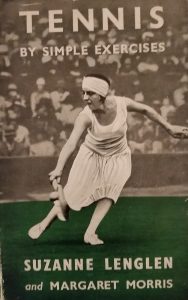
Suzanne Lenglen and Margaret Morris demonstrating a tennis exercise, c.1937. Margaret Morris Collection, Fergusson Gallery, Perth
Today marks the birthday of the tennis star Suzanne Lenglen, who was born in Paris in 1899. Regarded by some as the greatest female tennis player in history, Lenglen won 31 Championship titles between 1914 and 1926. She was also one of the first female international sports personalities and was nicknamed “La Divine” (The Goddess) by the French press. As a child however, she suffered numerous health problems including chronic asthma. Her father Charles suggested that it would be good for her to build up her strength by playing tennis and developed various exercises for her. Only four years later she was competing in the final of the 1914 French Championships, aged only 14.
Charles Lenglen’s approach would have found favour with Margaret Morris, who believed strongly that movement and exercise could be applied to improve the health, wellbeing and physical strength of anyone and everyone. She gave the first demonstration of her Margaret Morris Movement technique to doctors in 1925 and went on to train in Physiotherapy at St Thomas’s Hospital, London, passing with distinction in 1930.
Morris began to notice the striking similarity between the physical positions in her own exercises and those which occur in sports such as football, cricket and tennis. She demonstrated that all athletic movements were based on the opposition of one group of muscles to another. This idea of ‘opposition’ was fundamental to Morris’s technique – and indeed the development of free dance as a whole – and was heavily influenced by the teachings of Raymond Duncan (brother of the famous dancer Isadora) on the ‘Greek positions’ based on the Parthenon sculptures.

Dancer Jack Skinner and cricketer Donald Bradman. Illustrations from the prospectus of the Basic Physical Training Association, 1938. Margaret Morris Collection, Fergusson Gallery, Perth
Morris began to illustrate her demonstrations of opposition exercises with photographs of athletes, including Suzanne Lenglen. At one lecture in Paris, Lenglen, who by now had retired and was running a tennis school in the city, happened to be in the audience. Realising the potential for Morris’s exercises to be specially adapted for tennis and used as basic preparatory training, Lenglen invited Morris to collaborate with her. The pair developed exercises over a course of visits to Lenglen’s flat in Passy, where Morris was introduced to some of her tennis star friends.
Before leaving Paris, Morris taught the exercises to one of her teachers who worked each day at Lenglen’s school. It became compulsory for all of her pupils to learn the strokes by doing the exercises before they were allowed to pick up a tennis racket, as well as practicing the special breathing exercises developed by Morris. Lenglen apparently declared that results were obtained much faster and that the pupils had more endurance. Hearing of this, some of her tennis star friends, including “Bunny” Austin, began private lessons with Morris to improve their own style and technique.
Encouraged by this, Lenglen and Morris approached Heinemann’s to publish their exercises in book form and Tennis By Simple Exercises first appeared in 1937. It went into two editions and was later published in France under the title Initiation au Tennis. The Margaret Morris archive at the Fergusson Gallery in Perth has a number of first editions of the book, including Morris’s personal copy, as well as draft manuscripts, notes and correspondence between Morris and Lenglen.

‘Tennis By Simple Exercises’, Suzanne Lenglen and Margaret Morris (Heinemann, 1937), 1st edition. Margaret Morris Collection, Fergusson Gallery, Perth

‘Tennis By Simple Exercises’, Suzanne Lenglen and Margaret Morris (Heinemann, 1937), 2nd edition. Margaret Morris Collection, Fergusson Gallery, Perth
Morris later recalled being invited with Lenglen to a tennis party given by the politician and tennis player Domini, Lady Crosfield, and asked to demonstrate the exercises for the guests. When they had finished, Morris was surrounded by an admiring crowd clamouring “Now, of course, we are just longing to see you play!” Embarrassed, Morris was obliged to reply “But I don’t!” and had to explain to a sea of astonished faces that her varied and busy career gave her little opportunity to play any games herself!
Sadly, Suzanne Lenglen was diagnosed with leukemia in June 1938 and died only a month later, aged just 39. Reminiscing about their collaboration, Morris recalled:
She was a dynamic personality, stimulating to work with, and I never saw a sign of the violent temper she was reputed to possess.

Suzanne Lenglen and Margaret Morris demonstrating a tennis exercise, c.1937. Margaret Morris Collection, Fergusson Gallery, Perth
References
Margaret Morris, My Life in Movement (London: Peter Owen Limited, 1969)
“Suzanne Lenglen”, Wikipedia, https://en.wikipedia.org/wiki/Suzanne_Lenglen, accessed 17 May 2018.
Clare Button
Project Archivist
